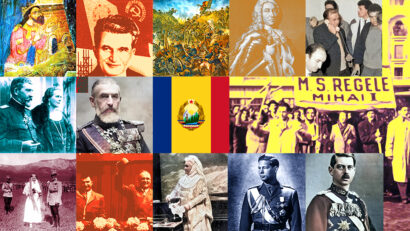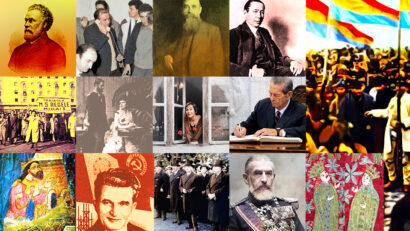100 years of captivity for Romania’s treasury in Russia
There is a saying that countries know no friends, only their own interests. But history has proved this oversimplifying statement to be wrong.

Steliu Lambru, 26.12.2016, 13:50
There is a saying that countries know no
friends, only their own interests. But history has proved this oversimplifying
statement to be wrong. The past is filled with examples of friendly relations
between countries that translated into military alliances, marriage
arrangements or the entrustment of secrets and assets. There are quite a number
of cases where a country has entrusted its own treasure for safekeeping to
another country, in an attempt to prevent its most cherished assets from
falling into the enemy’s hands. Such was the case of the Polish treasure hosted
by Romania in September 1939, at a time when Poland was attacked by both Nazi
Germany and the Soviet Union.
But alliances, just as friendships, can be
deceptive. During the Great War, Romania joined the Entente made up of France,
England and Russia. In the name of the friendly relation between the two
states, Romania’s treasure was transported to Moscow lest it should be seized
by the German troops that occupied Bucharest and most of southern Romania in
December 1916. Over December 12-14, some 1738 crates were loaded into 17
carriages in the railway station in Iasi, northern Romania. The crates
contained Romania’s gold deposits, comprising both ingots and various coins.
Its approximate value at the time was 315 million gold lei. Another two crates
contained the personal jewels of Queen Marie, estimated at 7 million gold lei.
The transport reached Moscow on December 21, 1916.
A second shipment was made in summer the next
year. Three train carriages were loaded with the assets of the National Bank of
Romania, in the amount of 1.6 billion lei, of which the gold itself accounted
for 575,000 lei, the archives were put at 500,000 lei, while the remaining
75,000 were bonds, assets, deposits and other valuable goods. Another 21
carriages contained 1,661 boxes with the assets of the House of Deposits, worth
7.5 billion lei. The second shipment reached Moscow on the 3rd of August
1917 and also contained other private assets and art collections meant to be
stored in the Kremlin.
Historian Ioan Scurtu says the loss suffered by
Romania with the departure of its treasures to Russia is hard to estimate:
Romania lost at that time the treasure of the
National Bank that ensured the normal circulation of money across Romania.
Apart from the National Bank treasure, there were many other assets that much
exceeded the value of this treasure, consisting in 93 tonnes of gold ingots. There
were art objects, paintings, religious objects, carpets and other artefacts of
historical and sentimental value. I don’t even believe one can make an
estimation of how much the Romanian treasure was worth in any national
currency, whether lei, dollars or rubles, because some of the pieces are very
difficult to evaluate. How can you evaluate, for example, a baptismal font from
the 15th century? Its artistic value alone, the craftsmanship,
exceeds the value of the metal of which it is made. Romania is poorer for
losing this treasure, for trusting that it will be returned to it based on the
word of civilised nations that have respect for international law.
The Bolshevik revolution led to the severance
of diplomatic ties between Romania and Russia in January 1918, at Lenin’s
initiative, in a diplomatic letter addressed to the Romanian government. It was
stated in this letter that Romania’s treasure would remain in Russia to be
denied to the Romanian oligarchy and to be one day returned to the working people.
We asked historian Ioan Scurtu whether Romania’s government at the time didn’t
have a better option than to send the country’s treasure to Russia:
There was the idea of sending the treasure to
Sweden, where it would have been safer, but transportation was a problem. How
could we have sent it to Sweden without the German troops capturing it? We have
the benefit of hindsight so we can say now that it was a mistake to send the
treasure to Russia. But I don’t think we can say the same thing if we try to look
at it from the point of view of those who made this decision back then. I would
also like to point out that there was a general obsession, in 1917, that
Moldavia would be occupied. Many MPs had already left Iasi and had taken refuge
in Odessa. There were even suggestions that the Cabinet itself ought to leave
the city of Iasi, and King Ferdinand and Bratianu had to talk the ministers
into staying. The government as a whole shared that obsession; there are
accounts of the scope of that psychosis. As the Liberal politician I. G. Duca
explained, the trains were already loaded and there were people bringing in
more and more cases with items to be put on the trains to Moscow, from where
they were supposed to be recovered after the war. The government shared that
obsession and there was no way of predicting what was about to happen, namely
that Russia would not keep its promise.
At the end of the war, the Romanian diplomacy
repeatedly initiated negotiations to recover the treasure. In 1935, the USSR
returned the archives and the documents of the Romanian Academy, and in 1956 it
decided to return a small part of the gold, the most notable item of which was
the Pietroasele treasure, dubbed the Hen with Golden Chicks. Although in July
2003, when a bilateral treaty was signed by Romania and the Russian Federation,
the issue of the treasure was scheduled to be discussed, a solution is yet to
be found. One hundred years on, the Romanian treasure is still in Moscow, a
prisoner of a disloyal friendship.





























